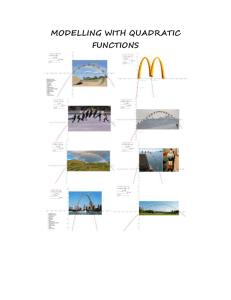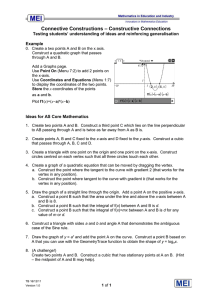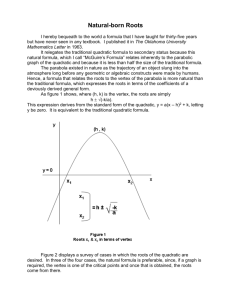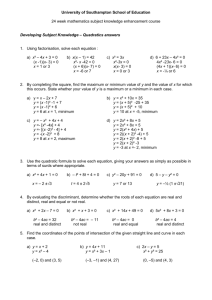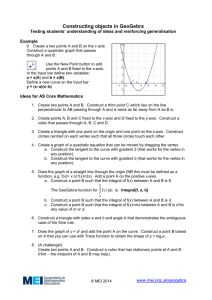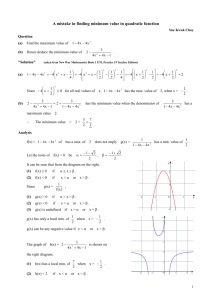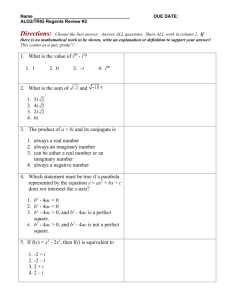ax2 +bx+c=0 x2 − 8x + 15 = 0 (x − 5)( x − 3) = 0 x − 5 = 0 x = 5 x − 3
advertisement
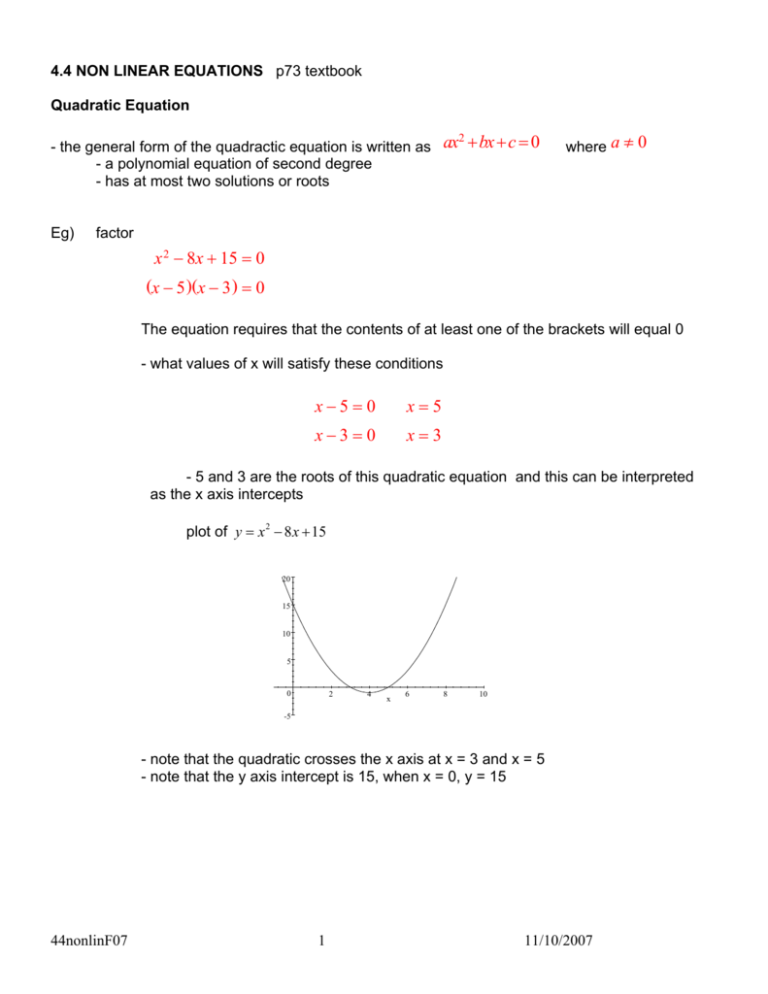
4.4 NON LINEAR EQUATIONS p73 textbook Quadratic Equation 2 - the general form of the quadractic equation is written as ax +bx +c = 0 - a polynomial equation of second degree - has at most two solutions or roots Eg) where a ! 0 factor x 2 − 8x + 15 = 0 (x − 5 )(x − 3 ) = 0 The equation requires that the contents of at least one of the brackets will equal 0 - what values of x will satisfy these conditions x−5=0 x=5 x−3=0 x=3 - 5 and 3 are the roots of this quadratic equation and this can be interpreted as the x axis intercepts plot of y = x 2 − 8 x + 15 20 15 10 5 0 2 4 x 6 8 10 -5 - note that the quadratic crosses the x axis at x = 3 and x = 5 - note that the y axis intercept is 15, when x = 0, y = 15 44nonlinF07 1 11/10/2007 Eg) solve or find the roots of x 2 + 5x = 0 x(x + 5 ) = 0 x=0 x+5=0 Eg) x = −5 find the roots or solve 7x 2 − 3 = 0 7x 2 = 3 x2 = 3 7 x=! 3 7 Eg) solve 5x 2 = 15x 5x 2 − 15x = 0 5x(x − 3 ) = 0 x=0 x−3=0 x=3 Eg) solve 16x 2 − 1 = 0 = (4x − 1 )(4x + 1 ) x = !1 4 44nonlinF07 2 11/10/2007 Eg) Solve skip this one x+ x−4 = 4 x−4 = 4−x x − 4 = (4 − x) 2 = 16 − 8x + x 2 x 2 − 9x + 20 = 0 (x − 5)(x − 4) = 0 x = 5, 4 -however x = 4 is an extraneous root - factoring up to this point involved integer or whole number factors Eg) factor x 2 + 4x − 2 = (x )(x )????? by inspection −b ! b 2 − 4ac x= 2a - apply the quadratic formula x 2 + 4x − 2 = 0 a = 1 b = 4 c = −2 20 15 −4 ! 4 2 − 4 % 1 % (−2 ) 2%1 −4 ! 24 = 2 = −4 ! 4.899 2 = −4.450, +0.449 10 x= 5 -5 -4 -3 x -2 -1 0 1 2 -5 x 2 + 4x − 2 = (x + 4.450 )(x − 0.449 ) = 0 44nonlinF07 3 11/10/2007 3 Eg) solve − x 2 − 3x + 2 = 0 a = −1 b = −3 c = 2 x= 3 ! 3 2 − 4 % (−1 ) % 2 2 % (−1 ) 4 2 -5 -4 -3 x -2 -1 3! 9+8 −2 3 − 17 3 + 17 = , −2 −2 = −3.562, +0.562 2 3 -2 = Eg) 1 0 -4 -6 -8 -10 solve x 2 − 4x + 5 = 0 a = 1 b = −4 c = 5 x= 4± ( −4 ) 2 − 4 × 1× 5 2 ×1 4 ± −4 imaginary solutlion 2 4 ± −4 4 ± 4 × −1 4 ± 4 −1 4 ± 2i = = = = = 2±i 2 2 2 2 = - since the square root of a negative number is not real, there are no real solutions for x 10 8 6 4 2 -2 0 2 4 x 6 8 -2 - no real solutions means that there are no crossings of the x axis Homework textbook pg 78 1, 3, 5, 7, 9 44nonlinF07 4 11/10/2007 The Discriminant can be used to test for real solutions D = b 2 − 4ac 15 - if D < 0 then there are no real solutions - if D = 0, then there is one real solution - if D > 0 then there are two real solutions Eg) 10 5 solve -5 x 2 + 3x − 2 = 0 -4 -3 x -2 0 -1 1 2 3 -5 a = 1 b = 3 c = −2 −3 ! 3 2 − 4 % 1 % (−2 ) x= 2%1 −3 ! 17 = 2 = −4 ! 4.123 2 = −8.123, +0.123 Eg) solve 3x 2 + 5x − 2 = 0 a = 3 b = 5 c = −2 20 x= −5 ± 52 − 4 × 3 × ( −2 ) 2×3 −5 ± 49 −5 ± 7 1 = = = −2, 6 6 3 15 10 5 -4 -3 -2 -1 0 -5 Demonstrate the use of the Sharp EL546W calculator for solving quadractic equations 44nonlinF07 5 11/10/2007 1 x 2 Eg) solve 3x 2 + 5x + 10 = 0 50 a = 3 b = 5 c = 10 40 −5 ! 5 2 − 4 % 3 % 10 x= 2%3 −5 ! −95 = 6 30 20 10 -4 -2 0 2 4 x - no real roots Eg) solve x2 − 2 = 0 10 8 a = 1 b = 0 c = −2 6 4 0 ! 0 2 − 4 % 1 % (−2 ) 2%1 ! 8 = 2 = !1.414 2 x= Eg) -3 -2 -1 0 1 2 x 3 -2 solve 2x 2 = 0 30 a=2 b=0 c=0 20 02 ! 0 − 4 % 2 % 0 2%2 = 0 =0 4 10 x= -4 -2 0 2 -10 Homework text p 78 11, 13, 15, 17, 19 44nonlinF07 6 11/10/2007 x 4 Sketching the Quadratic - the second degree polynomial produces a parabola - a sketch can be made by determining the following y orientation y Y-intercept y X-intercept y vertex y Eg) 25 sketch 20 y = 2x − 5x − 6 2 15 10 y = ax 2 + bx + c 5 0 -2 a = 2, b = −5, c = −6 0 2 -5 Graph paper printing software can be downloaded from http://perso.easynet.fr/~philimar/graphpapeng.htm y = ax 2 + bx + c a > 0 Opens up a < 0 Opens down Curve orientation ( 0, c ) Y-axis intercept X-axis intercepts Solve for the roots x= vertex −b! b 2 −4ac 2a x = −b 2a - since a > 0, then the curve opens up - y-axis intercept when x = 0 y = 2(0) 2 − 5 % 0 − 6 = −6 (0, −6) - x-axis intercepts 2 5 ! (−5 ) − 4 % 2 % (−6) 5 ! 73 x= = 2%2 4 x = −0.886, 3.386 - vertex −(−5) 5 x = −b = = = 1.25 2a 2 % 2 4 y = 2(1.25 ) 2 − 5(1.25 ) − 6 = −9.125 - by symmetry at y = -6, x = 2 X 1.25 = 2.5 44nonlinF07 7 (1.25, −9.125) ( 2.5, -6 ) 11/10/2007 4 x Eg) sketch y = −1x 2 + 8x − 16 y = ax 2 + bx + c a = −1, b = 8, c = −16 x -2.5 0 2.5 5 7.5 10 0 -12.5 - since a < 0, then the curve opens down -25 -37.5 - y-axis intercept when x = 0 y = −1(0) 2 + 8 % 0 − 16 = −16 (0, −16) -50 y - x-axis intercepts −8 ! 8 2 − 4 % (−1) % (−16) −8 ! 0 x= = −2 2 % (−1) x=4 - there is only one root - meaning that the curve is tangent to the x-axis at x = 4 - vertex x = −b = −8 = 4 2a 2 % (−1) y = −1(4 ) 2 + 8(4 ) − 16 = 0 By symmetry x = 2 X 4 = 8 44nonlinF07 (4, 0) ( 8, -16 ) 8 11/10/2007 Eg) sketch y = 3x 2 − 5x + 4 = 0 y a = 3, b = −5, c = 4 5 3.75 2.5 - since a > 0, then the curve opens up 1.25 0 -0.5 0 0.5 1 1.5 2 2.5 x - y-axis intercept when x = 0 y = 3(0) 2 − 5 % 0 + 4 = 4 (0, 4) - x-axis intercepts 5 ! 52 − 4 % 3 % 4 5 ! −23 = 2%3 6 x=4 x= - no real roots, the curve does not intersect the x axis - vertex x = −b = 5 = 5 = 0.833 2a 2 % 3 6 2 5 − 5 5 + 4 = 1.9 y=3 6 6 By symmetry x = 2 X (-0.833) = -1.7 44nonlinF07 9 (0.833, 1.9) ( -1.7, 4) 11/10/2007

